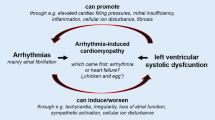Summary
Atrial fibrillation has been recognized and studied extensively in the early twentieth century, and since then reentrant excitation waves (reentry) have been favored as the main mechanism underlying this arrhythmia. The prerequisites of reentry are an inhomogeneous excitability and shortening of the excitation wavelength. Because of anisotropic conduction properties due to directional differences in cell coupling, inhomogeneous excitability is an inherent feature of atrial myocardium. Moreover, the inhomogeneity can be exaggerated by dilatation of the atria due to a spatially inhomogeneous increase in refractory period or by vagal stimulation due to a spatially inhomogeneous decrease in the refractory period. Likewise, interstitial fibrosis in congestive heart failure may enhance the anisotropy. Shortening of the excitation wave occurs, for instance, during high vagal or high sympathetic tone, or in hyperthyroidism; all three factors shorten the atrial refractory period, and thus, the excitation wavelength. However, the most important finding over the last several years is the recognition that tachycardiac stimulation induces alterations in the electrical properties of the atria, i.e. electrical remodeling, which results in shortening of the refractory period, possibly in a spatially inhomogeneous manner. Atrial remodeling is associated with a reduction in ion channel gene expression, and as a main consequence, with a reduction in L-type Ca2+ current. This results in a shorter atrial action potential and, hence, a decrease in refractory period. Thus, once initiated atrial fibrillation promotes its maintenance and re-initiation should it terminate. Furthermore, atrial remodeling may explain a variety of clinical observations, the increasing resistance to therapy of longer-standing atrial fibrillation, the tendency of paroxysmal atrial fibrillation to become chronic, and the decreasing risk of recurrence of atrial fibrillation after electrical cardioversion the longer sinus rhythm can be maintained, i.e. the more time has elapsed for remodeling to dissipate. In this context, it is worth mentioning that in rare cases of paroxysmal atrial fibrillation the tachycardia may be due to rapidly discharging foci. Then, radiofrequency ablation of the ectopic foci that trigger tachycardia-induced remodeling and, thus, atrial fibrillation may cure the arrhythmia.
Zusammenfassung
Als Pathomechanismus von Vorhofflimmern wird allgemein der Wiedereintritt bzw. das Kreisen von Erregungswellen (Reentry) postuliert. Die Grundvoraussetzungen für Reentry sind eine inhomogene Erregbarkeit des Vorhofmyokards und eine Verkürzung der atrialen Erregungswellenlänge. Aufgrund des unterschiedlichen Kopplungsgrad der atrialen Myozyten längs und quer zur Faserrichtung (Anisotropie) weist das Vorhofmyokard eine inhärente Inhomogenität der Erregbarkeit auf. Diese kann durch interstitielle Fibrose z.B. bei kongestiver Kardiomyopathie verstärkt sein. Ebenso führt Dilatation der Vorhöfe zu einer räumlich inhomogenen Verlängerung der Refraktärzeit. Vagale Stimulation verkürzt die Refraktärzeit ebenfalls inhomogen. Erhöhter Vagotonus, erhöhter Sympathicotonus und Hyperthyreose führen über unterschiedliche ionale Mechanismen zu einer Abnahme der atrialen Refraktärzeit und fördern somit Reentry durch die Verkürzung der Erregungswellenlänge. Besonders hervorgehoben werden müssen neuere Befunde, wonach längeranhaltende tachykarde Erregung die elektrische Eigenschaften des Vohofmyokards nachhaltig verändert (elektrisches „Remodeling”) und dadurch Reentry begünstigt: Die ionalen Mechanismen des Remodeling sind eine Reduktion des transienten K+-Auswärts-Stroms (Ito) und eine Reduktion des langsamen Ca2+-Einwärts-Stroms über L-Typ Ca2+-Kanäle (ICa,L), wobei besonders der letztgenannte Mechanismus zu einer Verkürzung der atrialen Refraktärzeit führt. Somit fördert einmal ausgelöstes Vorhofflimmern selbst sein Fortbestehen bzw. seine Re-Induktion. Klinische Beobachtungen wie die relative Therapieresistenz schon länger bestehenden Vohofflimmerns, die Neigung von gehäuft auftretendem paroxysmalem Vorhofflimmern zur Chronizität und die erhöhte Rezidivneigung in den ersten Tagen nach Kardioversion finden ihre Erklärung im atrialen „Remodeling“. In seltenen wenigen Fällen scheint zumindest der Induktion von paroxysmalem Vorhofflimmern frequente fokale Aktivität im Bereich der Pulmonalvenen-Einmündungen zugrunde zu liegen. Dies ist insofern bemerkenswert, als hier einerseits die fokale Aktivität über atriales Remodeling die Voraussetzungen für Reentry schaffen könnte, andererseits mittels Hochfrequenz-Katheterablation der „Foci“ eine ursächliche Therapie des Vorhofflimmerns möglich scheint.
Similar content being viewed by others
Author information
Authors and Affiliations
Additional information
Eingegangen: 8. Juni 2001 Akzeptiert: 11. Juni 2001
Rights and permissions
About this article
Cite this article
Weirich, J. Pathophysiologische Grundlagen von Vorhofflimmern. Herzschr Elektrophys 12, 68–74 (2001). https://doi.org/10.1007/s003990170026
Issue Date:
DOI: https://doi.org/10.1007/s003990170026




